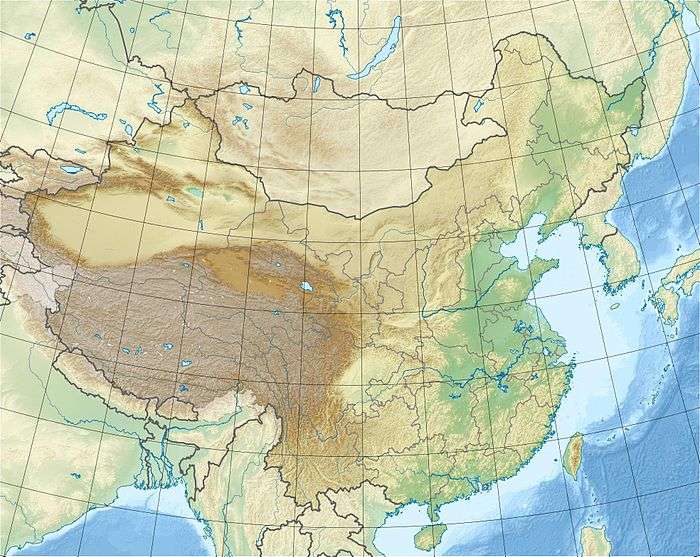Zhiren Cave
Zhiren Cave (Chinese: 智人洞) is a karstic cave in the Mulan Mountains that overlooks the Hejiang River in Chongzuo, Guangxi, China.[1] Zhiren Cave is an early Late Pleistocene site that has yielded the fossil remains of possibly anatomically modern humans with some mixed archaic human features.[1][2]
智人洞 | |
 location in China | |
| Location | Guangxi, China |
|---|---|
| Coordinates | 22°17′13.6″N 107°30′45.1″E |
| History | |
| Periods | early Late Pleistocene |
Fossils
The fossil remains were discovered by Chinese paleontologists in 2007.[1] The fossils were covered by a continuous layer of flowstone, a layer that was initially dated to around 113,000 to 100,000 BP.[1] A more thorough re-dating was later undertaken, and gives an estimated date of around 116,000 to 106,000 BP.[3]
Some of the large mammal remains discovered at Zhiren Cave include those from Pongo pygmaeus, Elephas kiangnanensis, Elephas maximus, Megatapirus augustus, Rhinoceros sinensis, Megalovis guangxiensis, Cervus unicolor, Ursus thibetanus, Arctonyx collaris and Panthera pardus.[1] Around 25% of the large mammal species discovered at the site are now extinct.[4]
Three pieces of hominin remains were identified: two upper molars (Zhiren 1 and Zhiren 2) and an anterior mandible (Zhiren 3).[1] The fossils are believed to have belonged to at least two different individuals, as Zhiren 1 and Zhiren 3 are unlikely to have come from the same individual.[1]
When compared to Late Pleistocene fossils from western Eurasia, Zhiren 1 and Zhiren 2 are smaller and would be classified as modern; however, the comparative context is lacking in East Asian Late Pleistocene fossils.[4][5] Zhiren 2 shows evidence for dental winging in its lower incisors, a feature that has only been found in Homo sapiens.[6]
Zhiren 3 contains a mix of archaic and modern human features.[1] The most significant aspect of Zhiren 3 is that it has a distinctively modern human chin.[1] Coupled with the dating, Zhiren 3 could possibly represent the earliest modern human fossil in East Asia.[1] However, many were skeptical of this conclusion, since this would significantly push back the general consensus on the dating of human migration out of Africa.[4][5] Peter Bellwood also cites the lack of archaeological finds (such as Neanderthal stone tools or tooth pendants)[7] associated with the fossils.[8]
See also
References
Citations
Bibliography
- Bellwood, Peter (2013). First migrants : ancient migration in global perspective. Chichester, West Sussex, UK Malden, MA: Wiley-Blackwell. ISBN 978-1-118-32589-6. OCLC 843455135.CS1 maint: ref=harv (link)
- Cai, Yanjun; Qiang, Xiaoke; Wang, Xulong; Jin, Changzhu; Wang, Yuan; Zhang, Yingqi; Trinkaus, Erik; An, Zhisheng (2017). "The age of human remains and associated fauna from Zhiren Cave in Guangxi, southern China". Quaternary International. Elsevier BV. 434: 84–91. doi:10.1016/j.quaint.2015.12.088. ISSN 1040-6182.CS1 maint: ref=harv (link)
- Dennell, Robin (November 2010). "Palaeoanthropology: Early Homo sapiens in China". Nature. 468 (7323): 512–513. doi:10.1038/468512a. PMID 21107416.CS1 maint: ref=harv (link)
- Dennell, Robin (2014). Southern Asia, Australia and the search for human origins. New York: Cambridge University Press. ISBN 978-1-107-01785-6. OCLC 841515684.CS1 maint: ref=harv (link)
- Kaufman, Rachel (October 25, 2010). "Oldest Modern Human Outside of Africa Found". National Geographic. Retrieved 24 May 2016.CS1 maint: ref=harv (link)
- Liu, W.; Jin, C.-Z.; Zhang, Y.-Q.; Cai, Y.-J.; Xing, S.; Wu, X.-J.; Cheng, H.; Edwards, R. L.; Pan, W.-S.; Qin, D.-G.; An, Z.-S.; Trinkaus, E.; Wu, X.-Z. (Oct 25, 2010). "Human remains from Zhirendong, South China, and modern human emergence in East Asia". PNAS. 107 (45): 19201–19206. doi:10.1073/pnas.1014386107. PMC 2984215. PMID 20974952.CS1 maint: ref=harv (link)
- Martinón-Torres, María; Wu, Xiujie; Bermúdez de Castro, José María; Xing, Song; Liu, Wu (2017). "Homo sapiens in the Eastern Asian Late Pleistocene". Current Anthropology. University of Chicago Press. 58 (S17): S434–S448. doi:10.1086/694449. ISSN 0011-3204.CS1 maint: ref=harv (link)